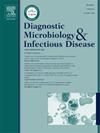加护病房患者中多味密蝇克隆爆发:泛耐药和相关死亡率的描述性分析
IF 1.8
4区 医学
Q3 INFECTIOUS DISEASES
Diagnostic microbiology and infectious disease
Pub Date : 2025-08-14
DOI:10.1016/j.diagmicrobio.2025.117066
引用次数: 0
摘要
芳香Myroides odoratimimus是一种非发酵的革兰氏阴性杆菌,越来越多地被认为是机会性卫生保健相关感染的原因,特别是在重症监护病房(icu)。它对多种抗生素的内在耐药性,包括碳青霉烯类、氨基糖苷类和多粘菌素,提出了严重的治疗挑战。在这里,我们报告了土耳其一家三级保健医院发生的尿尿多臭乳杆菌克隆爆发,涉及27名患者,时间长达7个月。所有患者均在icu住院并留置导尿。采用自动化系统鉴定分离株,并通过16S rRNA基因测序进行鉴定。克隆相关性由(GTG)₅-PCR确定,尽管在不同的ICU病房检测到,但所有分离株之间都显示出遗传同一性。所有菌株都表现出泛耐药表型,对包括粘菌素在内的所有测试抗微生物药物都具有耐药性。平均住院时间为61天,死亡率为70.3%,明显高于基于APACHE II评分和ICU背景死亡率的预测死亡率。环境培养均为阴性,可能是由于采样延迟或传统检测技术的限制。本研究强调了多药耐药病原菌在重症监护环境中引起持续克隆爆发的能力,强调了其作为多药耐药病原菌的临床意义,并强调了早期微生物鉴定、分子监测和强有力的感染控制策略的必要性。本文章由计算机程序翻译,如有差异,请以英文原文为准。
Clonal outbreak of Myroides odoratimimus in ICU patients: A descriptive analysis of pan-drug resistance and associated mortality
Myroides odoratimimus, a non-fermentative Gram-negative bacillus, has increasingly been recognized as a cause of opportunistic healthcare-associated infections, particularly in intensive care units (ICUs). Its intrinsic resistance to multiple antibiotic classes, including carbapenems, aminoglycosides, and polymyxins, presents serious therapeutic challenges. Here, we report a clonal outbreak of urinary M. odoratimimus involving 27 patients over a 7-month period in a tertiary care hospital in Turkey. All patients were hospitalized in ICUs and had indwelling urinary catheters. The isolates were identified using automated systems and confirmed through 16S rRNA gene sequencing. Clonal relatedness was determined by (GTG)₅-PCR, demonstrating genetic identity among all isolates despite their detection in different ICU wards. All strains exhibited a pan-drug-resistant phenotype, showing resistance to every tested antimicrobial, including colistin. The mean duration of hospital stay was 61 days, and the mortality rate was 70.3 %, notably exceeding predicted mortality based on APACHE II scores and the background ICU mortality rate. Environmental cultures were all negative, possibly due to delayed sampling or limitations of conventional detection techniques. This study highlights the ability of M. odoratimimus to cause persistent clonal outbreaks in critical care settings, underscores its clinical significance as a multidrug-resistant pathogen, and emphasizes the need for early microbiological identification, molecular surveillance, and robust infection control strategies.
求助全文
通过发布文献求助,成功后即可免费获取论文全文。
去求助
来源期刊
CiteScore
5.30
自引率
3.40%
发文量
149
审稿时长
56 days
期刊介绍:
Diagnostic Microbiology and Infectious Disease keeps you informed of the latest developments in clinical microbiology and the diagnosis and treatment of infectious diseases. Packed with rigorously peer-reviewed articles and studies in bacteriology, immunology, immunoserology, infectious diseases, mycology, parasitology, and virology, the journal examines new procedures, unusual cases, controversial issues, and important new literature. Diagnostic Microbiology and Infectious Disease distinguished independent editorial board, consisting of experts from many medical specialties, ensures you extensive and authoritative coverage.

 求助内容:
求助内容: 应助结果提醒方式:
应助结果提醒方式:


